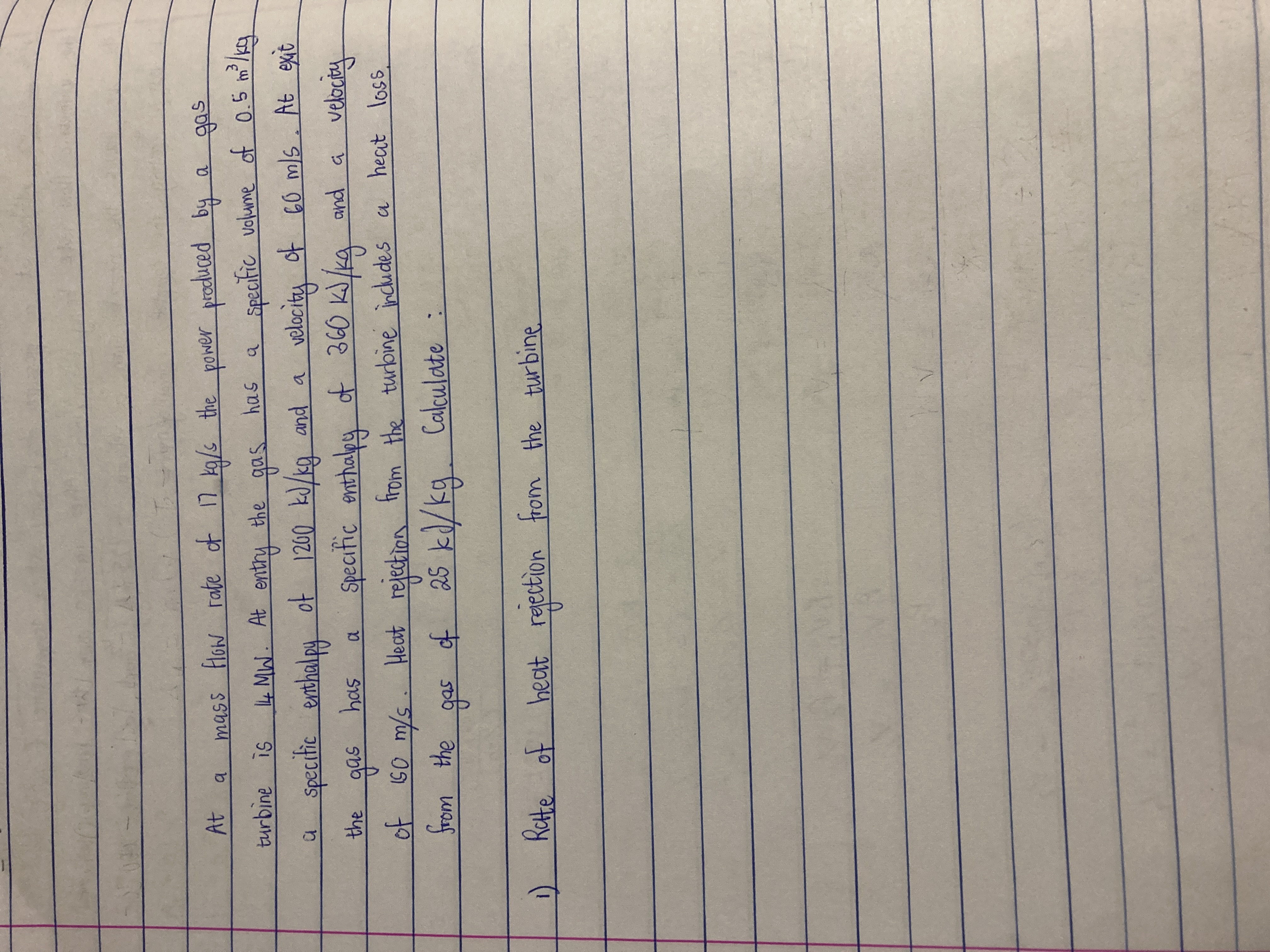
Elements Of Electromagnetics
7th Edition
ISBN: 9780190698614
Author: Sadiku, Matthew N. O.
Publisher: Oxford University Press
expand_more
expand_more
format_list_bulleted
Question

Transcribed Image Text:a.
4MW. At entry
the
as
velocity of 60 ms. At exit
turbine is
a Specitic enthalpy of 1200 kJ/kg and a
Specitic enthaly of 360 K)/Kg and a
টिल फटा
the
Heat refection heat loss
of
25kd/kq. Calculate :
from the turbine includes a
from the
Kette of heat regection from the turbine
Expert Solution
This question has been solved!
Explore an expertly crafted, step-by-step solution for a thorough understanding of key concepts.
Step by stepSolved in 2 steps with 2 images

Knowledge Booster
Learn more about
Need a deep-dive on the concept behind this application? Look no further. Learn more about this topic, mechanical-engineering and related others by exploring similar questions and additional content below.Similar questions
- The rest of the questions are thus: 4) Calculate the air temperature and pressure in the pump at the end of the following expansion stroke, just before the piston uncovers the orifice (orifice dimensions are neglectable).5) Calculate the mass and temperature of air in the pump (i.e. the cylinder andconnecting pipe) after the orifice has been exposed and the pressure has risen to atmospheric pressure (bottle valve is now closed).7) Calculate the piston position and the air temperature in the pump during the next compression stroke at the time when the valve to the gas bottle opens again.8) Calculate the pressure in the bottle when no more air can be transferred by the pump. (This will be after an undetermined number of pumping cycles).arrow_forwardThe 36% -in pump of the figure below is to pump 20,000 gpm of water at 1,170 rpm from a reservoir whose surface is at atmospheric pressure (i.e. 14.7 psia). a) If head loss from the reservoir to the pump inlet is 6 ft, where should the pump inlet be placed to avoid cavitation for water. The vapor pressure of water at 60°F is 0.26 psi. b) Determine the required brake horsepower. pressure differential across it, is to be fixed at 1 m of mercury (density = 13,600 kg/m³). 50 c) The water is to be transported in an 80 cm pipe, and the engineer would like to measure the flow rate downstream of the pump using an orifice meter. What should be the orifice meter diameter if the 40 n = 1170 r/min 30 NPSH |20 700 - 362 in dia.. 600 32 in dia. 500 3500 bhp 3000 bhp 2500 bhp. 400 28 in dia." 2000 bhp 1500 bhp 300 20 24 28 16 8 12 US gallons per minute x 1000 200 (From Ingersoll-Rand Corporation, Cameron Pump Division) Total head, ft %88 %Z8- %8L NPSH, ftarrow_forwardA reciprocating compressor is operating at 800RPM. Suction pressure and discharge pressure are held constant by other means that have nothing to do with the compressore . The speed is increased from 800 - 840 Rpm (a 5% increase) a) What is the change in the flow rate through the compressor? b) What is the change in the pressure rise through the compressore? c) What is the change in the power that must be delivered to the compressor?arrow_forward
- intake vaive iii) iv) intake vi) on covers the compression laru Tuel injector power The diagrams show the cylinder of a petrol engine in 4 stages. Petrol vapour and air are drawn into the cylinder, The mixture is then squeezed together, and then exploded by a spark. The explosion pushes down the piston. The exhaust gases are then expelled from the cylinder. exnaust vaive 010 Use the first law of thermodynamics to analyse the energy changes during the process. At each stage explain what happens to the pressure of the gas; exhaust the temperature of the gas; the number of molecules in the cylinder; the internal energy of the gas; the work done on or by the gas: the thermal energy exchanged with the environment. [AC 4.3]arrow_forward7)arrow_forward
arrow_back_ios
arrow_forward_ios
Recommended textbooks for you
 Elements Of ElectromagneticsMechanical EngineeringISBN:9780190698614Author:Sadiku, Matthew N. O.Publisher:Oxford University Press
Elements Of ElectromagneticsMechanical EngineeringISBN:9780190698614Author:Sadiku, Matthew N. O.Publisher:Oxford University Press Mechanics of Materials (10th Edition)Mechanical EngineeringISBN:9780134319650Author:Russell C. HibbelerPublisher:PEARSON
Mechanics of Materials (10th Edition)Mechanical EngineeringISBN:9780134319650Author:Russell C. HibbelerPublisher:PEARSON Thermodynamics: An Engineering ApproachMechanical EngineeringISBN:9781259822674Author:Yunus A. Cengel Dr., Michael A. BolesPublisher:McGraw-Hill Education
Thermodynamics: An Engineering ApproachMechanical EngineeringISBN:9781259822674Author:Yunus A. Cengel Dr., Michael A. BolesPublisher:McGraw-Hill Education Control Systems EngineeringMechanical EngineeringISBN:9781118170519Author:Norman S. NisePublisher:WILEY
Control Systems EngineeringMechanical EngineeringISBN:9781118170519Author:Norman S. NisePublisher:WILEY Mechanics of Materials (MindTap Course List)Mechanical EngineeringISBN:9781337093347Author:Barry J. Goodno, James M. GerePublisher:Cengage Learning
Mechanics of Materials (MindTap Course List)Mechanical EngineeringISBN:9781337093347Author:Barry J. Goodno, James M. GerePublisher:Cengage Learning Engineering Mechanics: StaticsMechanical EngineeringISBN:9781118807330Author:James L. Meriam, L. G. Kraige, J. N. BoltonPublisher:WILEY
Engineering Mechanics: StaticsMechanical EngineeringISBN:9781118807330Author:James L. Meriam, L. G. Kraige, J. N. BoltonPublisher:WILEY

Elements Of Electromagnetics
Mechanical Engineering
ISBN:9780190698614
Author:Sadiku, Matthew N. O.
Publisher:Oxford University Press

Mechanics of Materials (10th Edition)
Mechanical Engineering
ISBN:9780134319650
Author:Russell C. Hibbeler
Publisher:PEARSON

Thermodynamics: An Engineering Approach
Mechanical Engineering
ISBN:9781259822674
Author:Yunus A. Cengel Dr., Michael A. Boles
Publisher:McGraw-Hill Education

Control Systems Engineering
Mechanical Engineering
ISBN:9781118170519
Author:Norman S. Nise
Publisher:WILEY

Mechanics of Materials (MindTap Course List)
Mechanical Engineering
ISBN:9781337093347
Author:Barry J. Goodno, James M. Gere
Publisher:Cengage Learning

Engineering Mechanics: Statics
Mechanical Engineering
ISBN:9781118807330
Author:James L. Meriam, L. G. Kraige, J. N. Bolton
Publisher:WILEY